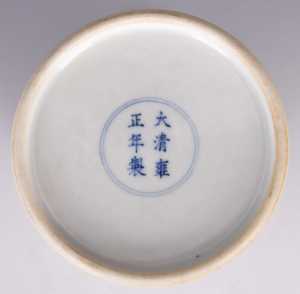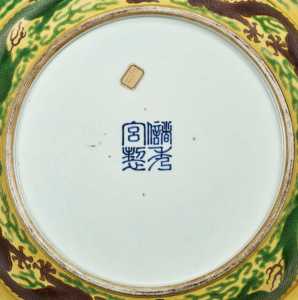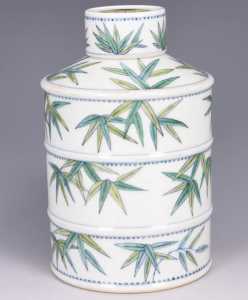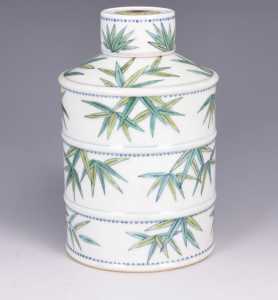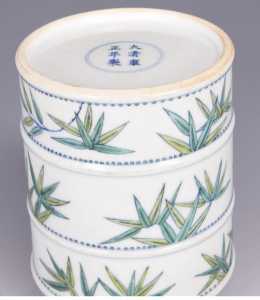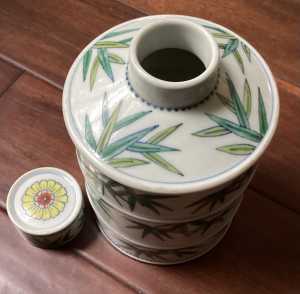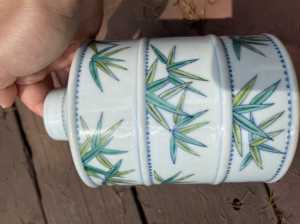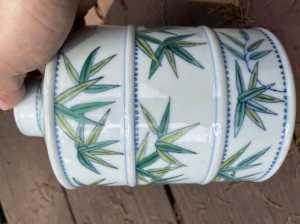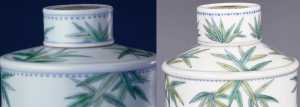The Chinese and Asian Art Forum. For Fans, Collectors and Dealers.
 Basic Rules For the BidAmount Asian Art Forum: Talk about whatever you want. You can even discuss and offer things that are for sale if they are authentic. Maximum image file size per post is 2 MB. Images of 700pxl x 700pxl are optimal if saved at a medium resolution. Be respectful of others and enjoy yourself. Click the YouTube link for a brief tutorial on using the forum. You can also EMBED Videos by cutting and pasting from You-Tube, Vimeo etc.
Basic Rules For the BidAmount Asian Art Forum: Talk about whatever you want. You can even discuss and offer things that are for sale if they are authentic. Maximum image file size per post is 2 MB. Images of 700pxl x 700pxl are optimal if saved at a medium resolution. Be respectful of others and enjoy yourself. Click the YouTube link for a brief tutorial on using the forum. You can also EMBED Videos by cutting and pasting from You-Tube, Vimeo etc.
NOTE: To post an item or add a new post, click open the category title from the FORUM LIST, and CLICK the Blue ADD TOPIC button.
Me again with questions about the foots. 🙂
One is a yongzheng doucai, anything wrong jumping out to you?
And the other is one for guangxu period. Does this seem right?
They look like good feet & marks, but Guangxu seal marks are a bit unusual- I can see a bit of the famille jaune dragon design - looks well rendered.
Why are you focused on the feet/mark given our earlier discussion of the importance of evaluating the entire piece?
@greeno107 just learning. More on the first one. Could be a copy, but not sure how to tell. Appreciate your insights.
@zhtail Thank you for posting the photos.
I’m not familiar with the vessel shape, a covered bottle. I’ll continue to look, but it seems an odd and utilitarian form for mark and period work.
The rendering is overly simple, and the color lacks the vibrance of other known Yongzheng doucai porcelain depicting bamboo.
Compare:
https://www.christies.com/en/lot/lot-4268612
@greeno107 yes, I agree with you that that’s where is concerning. This is the one in the museum, just as a reference for the form and rendering
https://www.dpm.org.cn/collection/ceramic/227057.html?hl=斗拱
@zhtail Thank you for the link.
I notice the proportions of your jar is more elongated while the museum form is more compressed.
Comparing color is difficult because photographs vary with lighting.
The amount of the open space and bamboo leaves is quite different- it changes the whole appearance of the two vessels.
They do not look to be of the same period.
However, I would like to see your jar in better light and close up of the enamel?
Just an observation, the National Palace Museum has a Kangxi blue & white example. If the Yongzheng emperor re-ordered a rather out of fashion item with newer modern enamels, then imperial records would record the order.
Throughout my collecting activities, I have always been highly suspicious of any imperial marks on any porcelain that has been offered to me for sale. It is important to remember that 99.9% of the time the ‘real thing’ is only handled by dealers with impeccable reputations or major auction houses. If you have the economic resources to pursue mark & period wares, then I urge you to cultivate a long term relationship with one or more international dealers or auction houses. They will happily guide you in collecting only the best.
However, if like the rest of us you have limited funds to pursue your collecting activities, I urge you to stop focusing on mark & period porcelain. Turn your attention to wares in the marketplace that attract your interest and are within your economic means. Start a study collection sourced from reputable vendors that can include less high end examples or better things with damage. You will never learn anything of true value about Chinese ceramics unless you can hold them in your hands and live with them for years. There are many 18th century porcelains that are still relatively affordable.
@greeno107 the size is actually pretty close, if not the same. Must be the pictures. Not sure how to take better pictures of the enamel, so let me know if the attached works.
@zhtail I think William has a strong argument... in 12 years of very aggressive searching (trust me, I go everywhere), I've only come across 1 genuine Yongzheng M & P piece, and only a handful of 19th c. M&P pieces...they are quite scarce.
As for your jar, I think the rendering looks well done, but quite different than the museum example...they do not appear to be of the same period.
Take a look:
@zhtail The funnel shaped neck is shorter in the museum example...longer in yours. Variation always concerns me, however, it is very pretty in the natural light.
Perhaps your example is a very well made Republic copy of imperial ware?
I would suggest you pursue having a museum or high end auction house take a look. Good luck!
@greeno107 totally agree! Rather this is a well made copy that I accepted. 🙂
Good advice given on this thread. I know many veterans suggest looking at as many "authentic" pieces as possible, but as a newbie, I've actually found looking at "fakes" (the good ones) just as constructive. I think by doing so keeps my guard up and reminds me of how realistic the fake renditions can be. And sometimes I find looking at an object "blind" (as in not knowing the source) is also a good way to learn because once you realize where it's coming from (Sotheby's instead of some unknown ebay seller), then biases start kicking in.
@singingteapot The learning process is interesting and unique for each person. I have found value in looking at both authentic items and fakes. My feeling is that it is good to understand the qualities of both. However, the further along I go, the more I find myself just wanting to see mainly the good stuff. Although, I do admit to being intrigued by some of the fakes and how impressive they can be, and so I do think it is worth staying aware of what reproductions are out there in the market, so as to better be able to recognize them quickly.
Thanks for visiting "The BidAmount Asian Art Forum | Chinese Art"
If you sell on eBay, or have a shop feel free to post images and descriptions and links.
Check back often for discussion about the latest news in the Chinese art and antique world. Also find out about the latest Asian art auctions at Sotheby's, Christie's, Bonhams and Tajans.
Auction results for: fine porcelain, ceramics, bronze, jade, textiles and scholar's objects. As well as Japanese, Thai, Vietnamese and other Asian cultures.
Thank you,
Peter Combs
Topics and categories on The BidAmount Asian Art Forum | Chinese Art
Kangxi vases, Kangxi dishes and chargers, Kangxi ritual pieces, Kangxi scholar's objects, Qianlong famille rose, Qianlong enamels, Qianlong period paintings, Qianlong Emporer's court, Fine porcelain of the Yongzheng period. Chinese imperial art, Ming porcelain including Jiajing, Wanli, Xuande, Chenghua as well as Ming jades and bronzes.
The BidAmount Asian Art Forum | Chinese Art
A free Asian art discussion board and Asian art message board for dealers and collectors of art and antiques from China, Japan, Korea, Thailand, Cambodia, Vietnam and the rest of Asia. Linked to all of the BidAmount Asian art reference areas, with videos from plcombs Asian Art and Bidamount on YouTube. Sign up also for the weekly BidAmount newsletter and catalogs of active eBay listing of Chinese porcelain, bronze, jades, robes, and paintings.
The art of calligraphy - and for the ancient Chinese it certainly was an art - aimed to demonstrate superior control and skill using brush and ink. Calligraphy established itself as one of the major Chinese art forms during the Han dynasty (206 BCE - 220 CE), and for two millennia after, all educated men were expected to be proficient at it.
The Museum’s collections of Asian art span nearly five millennia and encompass the cultures of China, the Himalayas, India, Japan, Korea, and Southeast Asia. In 2007, the Museum launched an initiative to create dedicated galleries for the collection, beginning with a gallery for the arts of Korea ...
Chinese art is full of symbolism, in that artists typically seek to depict some aspect of a totality of which they are intuitively aware.
China Online Museum is the finest online museum of Chinese art. It features Chinese calligraphy, painting, ceramics, bronzes, carving, and other artworks.
Chinese Ceramics & Works of Art. Overview Upcoming auctions Contacts Auction results ... Christie’s sales of Chinese ceramics and works of art showcase centuries of Chinese history. Held throughout the year in London, New York, Paris and Hong Kong, they attract a wide audience of collectors and connoisseurs vying for pieces as diverse as ...
Explore Asian Art Week. Contact the Specialist Department. Chinese Paintings ... Senior Specialist, Head of Sale. [email protected]. Tel:+1 212 641 5760. Bid in-person or online for the upcoming auction:Fine Chinese Paintings on 10 September 2019 at New York. Bid in-person or online for the upcoming auction:Fine Chinese Paintings on 10 ...
Discover an abundance of must-see art from all corners of a vast continent at Christie’s NY Asian Art Week. From contemporary classical and Chinese paintings to works with exemplary provenance from the Art Institute of Chicago, our Rockefeller Paza galleries will be full of ancient treasures and contemporary masterworks in a salute to the vibrant arts of Asia.
Sold to benefit The Art Institute of Chicago’s Asian Art Acquisition Fund, the sale features 84 lots with a focus on Ming and Qing porcelains, and offers a rare insight into the taste for collecting Chinese ceramics and works of art in the Midwest from the end of the 19th century through the 1980s. Highlights include two Wanli wucai garlic-head vases, a Qianlong mark and period, blue and ...
Specialist, Chinese Paintings, Christie's London Dr Malcolm McNeill is a Specialist in Chinese Paintings at Christie’s, based in London. He previously worked as an assistant curator of the Chinese collections and the Victoria and Albert Museum in London, as a researcher at the British Museum, and as a translator and tour guide at the National Palace Museum in Taipei.
The Christie's Education 2020 Conference: The Chinese Art Market 18 Jun 2019 Christie’s Education is delighted to announce our first international academic conference in Asia which will take place in Hong Kong from 26-27 November 2020 at the Hong Kong Convention and Exhibition Centre and will run in parallel with Christie’s Hong Kong Autumn Auctions.
The summer Chinese Art sale in Hong Kong will feature works of art from several private collections, including Qing porcelains and textile from the collection of the legendary Chinese art dealer A. W. Bahr (1877–1959), fine gilt bronze Buddhist sculptures from an old Hong Kong collection, an East Asian collection of Qing dynasty wine cups and jades, and a Japanese collection of Song ceramics ...
Sotheby's Chinese Works of Art Department holds two auctions each year in London, New York, Hong Kong and Paris.
Chinese Art - View Auction details, bid, buy and collect the various artworks at Sothebys Art Auction House.
With more than 340 Chinese works of art dating from the Neolithic to the Republic periods, highlights of this sale include a selection of Qing Imperial monochromes from the collection of Arnold and Blema Steinberg, early ceramics from the Art Institute of Chicago and Chinese porcelain and works of art from the collection of Henry Arnhold.
Results: Sotheby's Asia Week achieved $52.4 million in six strong auctions, exceeding pre-sale estimates. With 76.5% of lots sold and 60.3% of lots surpassing high estimates, the Asian art sales at Sotheby's indicate continued collector interest in the finest works of art from China, India and and the Himalayas.
Today's sale of Important Chinese Art will proceed as planned with sessions at 10 AM and 2 PM EDT. Sotheby's will be monitoring the weather conditions throughout the day and will be available to coordinate alternative bidding options should conditions make it difficult for clients to attend the auction in person.
Bonhams Chinese Art department is renowned for offering the finest works of art representing the richness and breadth of China's artistic heritage, particularly Imperial porcelain, white and spinach green jades, cloisonné and Buddhist art. Specialised international auctions are held globally, including London, Hong Kong and San Francisco.
Bonhams : Chinese Works of Art We use cookies to remember choices you make on functionality and personal features to enhance your experience to our site. By continuing to use our site you consent to the use of cookies. Please refer to our privacy and cookie policies for more information.
Bonhams Fine Art Auctioneers & Valuers: auctioneers of art, pictures, collectables and motor cars. We use cookies to remember choices you make on functionality and personal features to enhance your experience to our site. By continuing to use our site you consent to the use of cookies. ... Chinese Art (US) General enquiries
Bonhams : Fine Chinese Art We use cookies to remember choices you make on functionality and personal features to enhance your experience to our site. By continuing to use our site you consent to the use of cookies. Please refer to our privacy and cookie policies for more information.
Bonhams Fine Art Auctioneers & Valuers: auctioneers of art, pictures, collectables and motor cars Bonhams : Asian Art We use cookies to remember choices you make on functionality and personal features to enhance your experience to our site.
Bonhams are international auctioneers of fine Chinese and Japanese art. We specialise in rare Imperial and Export Chinese ceramics and works of art, as well as Japanese ceramics, fine and decorative works of art from the Neolithic Period to the 20th century. View on map
Bonhams Fine Art Auctioneers & Valuers: auctioneers of art, pictures, collectables and motor cars. We use cookies to remember choices you make on functionality and personal features to enhance your experience to our site. By continuing to use our site you consent to the use of cookies. ... Asian Art Bonhams. Work. 22 Queen St.
